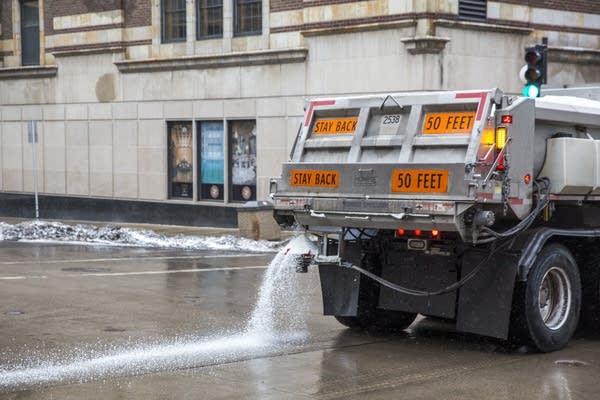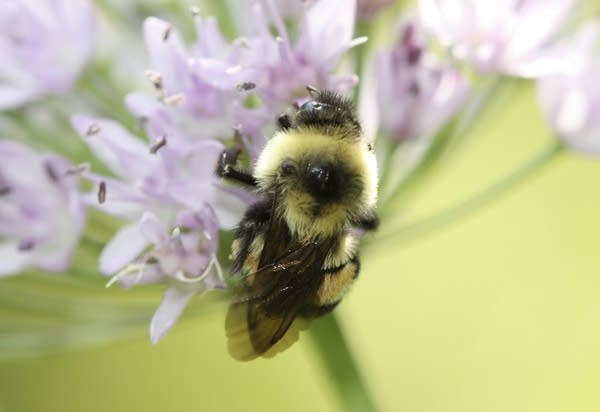Wolves, deer and a new state bee: How the environment fared at the Legislature

There was a lot of give-and-take at the last minute between Minnesota's DFL-controlled House and Republican-controlled Senate this legislative session.
Environmental, energy and natural resources issues took a back seat to the overall budget negotiations, as legislators spent most of their energy on passing a spending plan that will keep state government running for the next two years.
The Legislature began its four-month 2019 session in early January, when individual bills were introduced, debated and tweaked. Most of the bills were set aside and then included in giant omnibus bills that include both policy and funding.
In May, conference committees made up of Senate and House members negotiated details from both chambers' bills to come up with a series of two-year budget bills to fund state agencies, initiatives and programs.
Create a More Connected Minnesota
MPR News is your trusted resource for the news you need. With your support, MPR News brings accessible, courageous journalism and authentic conversation to everyone - free of paywalls and barriers. Your gift makes a difference.
Many of the bills under consideration — including those with provisions on environment, energy and natural resources — were agreed upon behind closed doors and then sent to the House and Senate floors for last-minute votes during a special session.
Gov. Tim Walz has now signed the bills into law.
Reporters on MPR News' regional and environmental team have been keeping track of many of the bills under consideration this session. Here's a final accounting of what passed, what failed and what changed.
Budgets for environment-related agencies
The Republican-controlled Senate proposed big cuts to state environmental agencies.
In the end, funding levels for the Minnesota Pollution Control Agency, Department of Natural Resources and the Board of Soil and Water Resources were closer to what the DFL-controlled House and Walz proposed.
Generally, the MPCA regulates industries that pollute water and air; the DNR oversees mining and logging, state parks and a variety of outdoor recreation activities; and BWSR works with local agencies to prevent soil erosion and improve water quality.
The Legislature also approved projects funded through the Environmental Trust Fund, which comes from lottery proceeds, and the Clean Water Land and Legacy Amendment. Both funds were set up by voters through constitutional amendments.
Nitrogen fertilizer rule
The Legislature did not do anything to change the rules put in place under Gov. Mark Dayton's administration to restrict how farmers can apply nitrogen fertilizer, the biggest source of nitrates in groundwater.
The MPCA had asked for funding for a groundwater environmental impact statement in southeastern Minnesota, but that did not go through.
The final legislation does provide $350,000 from the Environmental Trust Fund to improve nitrate reduction best management practices in southeastern Minnesota.
Road salt

Chloride contamination continues to be a threat to Minnesota's waters from road salt running off of streets and into waterways. And while municipalities and the state Transportation Department have been reducing their salt use, salt use isn't regulated among individuals or private companies.
A bill that would offer liability protection to private contractors who clear driveways, parking lots and sidewalks if they become certified in "smart salting" techniques did not survive the session.
But a state program on salt reduction did receive $500,000 in Legacy money.
Buffer compensation
Walz had proposed a tax credit for farmers who comply with the buffer law that requires grass or other perennials to be planted next to waterways as a means to improve water quality.
The Legislature did not pass the tax credit for buffers, but did pass other property tax changes that could benefit farmers, according to farm lobbyists.
Sustainable crop research
The University of Minnesota's Forever Green program, which is developing new crop varieties aimed at being both profitable for farmers and beneficial to Minnesota's environment, received $4.3 million from the Legacy Amendment's Clean Water Fund.
The House had proposed spending $10 million on the program.
Water infrastructure
The Legislature passed two bonding bills this session.
Early in the session, lawmakers addressed concerns about past use of the Environmental Trust Fund, which comes from state lottery proceeds, for infrastructure projects by committing bonding money for those projects.
A small bonding bill that was passed at the end of the session did not include any water infrastructure projects. Many cities have been faced with costly upgrades and repairs to aging drinking water and wastewater treatment systems and have asked the state for help.

Renewable energy mandate
The bill by the DFL-controlled House and Walz to require all electricity produced in the state to be carbon-free by 2050 did not pass this session after the Republican-controlled Senate opposed the measure.
Minnesota's current renewable energy mandate is 25 percent by 2025, and the state is already meeting that requirement. Advocates for climate change action say they'll push the carbon-free-by-2050 legislation again next year.
Nuclear energy moratorium
It has been illegal to build new nuclear power plants in Minnesota since the 1990s, and that moratorium will remain.
The Senate wanted to lift the ban, arguing nuclear is a reliable source of carbon-free energy. But the House disagreed, saying nuclear power is too expensive and arguing that, because it requires radioactive waste to be stored on site, it puts Minnesota communities at risk.
Meanwhile, Xcel Energy announced plans to ask federal regulators to extend its Monticello, Minn., nuclear plant's license by a decade as part of its efforts to offer 100 percent carbon-free electricity by 2050.
Outdoor recreation
The environment bill creates a new state office for outdoor recreation, though the office didn't get any funding this biennium.
The bill also included a provision for a new grant program called No Child Left Inside, aimed at getting kids into nature. It received $700,000 and will be administered by the DNR.
Outdoors enthusiasts will also see some new fees. Annual and daily cross-country ski passes for designated state ski trails will cost more, and boat licenses will include an increased watercraft surcharge that goes toward fighting aquatic invasive species.

Tough penalties for pipeline protesters
The Senate wanted to make it a felony to trespass on property and alter pipeline equipment with the intent of disrupting it. The proposal came after cases in Minnesota and elsewhere in which activists have shut off or attempted to shut off oil pipelines.
The Senate also wanted to bar the state Department of Commerce from spending money on its appeal of the Enbridge Line 3 oil pipeline project.
The project, which would replace an existing pipeline across northern Minnesota, was approved last year by the Minnesota Public Utilities Commission. But the Walz administration has continued an appeal of that decision, saying the pipeline isn't needed.
Neither of the provisions made it into final bill that funds energy and commerce programs.
Energy storage
Energy storage was one of the few issues that made it into the final energy bill, which includes language encouraging utilities to establish energy storage pilot projects and provides funding for a cost-benefit analysis of energy storage systems.
Energy storage, such as batteries that are paired with wind and solar energy projects, is seen as another way to reduce the need to burn coal and natural gas to generate electricity, and to make Minnesota's carbon-free energy goals more attainable.

Community solar
Both the House and Senate sought to change the state's community solar garden program, which allows both renters and homeowners to subscribe to a solar array and receive credits on their electricity bills. The program was created by the Legislature in 2013 and only the state's largest utility, Xcel Energy, is required to participate in it.
But a conference committee was unable to agree on any changes to current community solar guidelines.
Solar for schools
A bill that would provide funding for a new program to help schools install solar arrays through grants died in conference committee, even as both the House and Senate earlier had passed bills establishing and funding the program.

Chronic wasting disease
Chronic wasting disease has been a problem on several deer farms in the state, and animal health officials are concerned about it spreading further among wild deer. The disease is fatal. The final environment bill provides funding for the University of Minnesota to develop tests for chronic wasting disease. The bill also establishes mandatory surveillance of farmed deer and requirements for depopulating the herd when the disease is present.

Pollinators
The rusty patched bumblebee has become the official state bee of Minnesota, and the Environmental Trust Fund provides hundreds of thousands of dollars for pollinator-friendly programs.
But there's no language banning the use of neonicotinoid pesticides — a popular insecticide used on lawns, gardens and crops that are widely thought to play a role in the decline of bee populations — in state wildlife management areas. Both bodies had included differing neonicotinoid language in their earlier bills.
Wolf hunting ban
No ban on wolf hunting in Minnesota made it into the final bills.
The House had narrowly voted to ban recreational wolf hunting, but the Senate had no such provision.
Lawmakers did agree to spend $240,000 over the next two years on wolf-livestock conflict prevention grants.
Federal wildlife officials announced in March a plan to remove federal endangered species protections for gray wolves. The announcement came after a decadeslong effort to restore the gray wolf population in the United States, which federal officials said has been successful. Wolves have been on and off the federal endangered species list for years.
If the wolf is removed from the federal list, it would cede management authority of Minnesota's wolf population to state officials.
Use of dedicated environmental funds
The House and Senate were at odds this year over how to spend money from the Legacy Amendment's Clean Water Fund.
The funds are not supposed to be used to replace general state funding, but environmental groups had accused the Senate of doing exactly that, when it took $24 million from the Clean Water Fund to fund soil and water conservation districts.
The Senate's plan went through, but it's unclear whether environmental groups will challenge the state's funding decision in court as they have in the past.